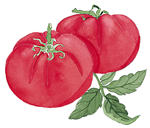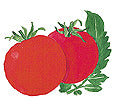
Easy and Delicious Dried Tomatoes
|
 Drying your tomatoes indoors is easiest because you provide reliably hot temperatures. Electric dehydrators have temperature controls and fans to do the very best job of circulating hot air to evaporate moisture efficiently.
Models come in a range of prices and sizes and are available at most appliance centers, and from mail order garden supply or seed catalogs that carry cooking and harvesting accessories. You can use electric dehydrators to dry all kinds of fruits and vegetables, make fruit leathers and even make a preservative-free meat jerky, so they are a good investment if you enjoy "putting foods by."
To use a dehydrator, follow the manufacturer's instructions for setting the temperature and rotating the trays once or twice for each batch. Drying time ranges from 8-16 hours depending on the thickness of your tomato pieces and the dehydrator's heat and air circulation system. The racks that come in most models are easy to clean and maintain.
You can also oven-dry your tomatoes, by putting them on single layers on wire racks or foil lined sheets in a 140 to 150 degree oven. This works best with a convection oven which has a fan to move the hot air. Space slices about an inch apart for best air circulation and plan to rotate the trays 3 or 4 times for even dehydration. |
Try these great recipes from Renee's cookbooks:  |
|
 Oven drying can take from 10 to 24 hours. Be sure to prop the oven door open very slightly with a wooden spoon so evaporating moisture can escape. Oven or dehydrator dried tomatoes should be non-sticky and leathery but still pliable, like dry raisins; be sure not to over dry. Oven drying can take from 10 to 24 hours. Be sure to prop the oven door open very slightly with a wooden spoon so evaporating moisture can escape. Oven or dehydrator dried tomatoes should be non-sticky and leathery but still pliable, like dry raisins; be sure not to over dry.
You'll find dried tomatoes add a wonderful concentrated tomato flavor to a wide variety of dishes. Snip into pieces to add to casseroles, soups and stews, or to top homemade pizza. Use slivers of re-hydrated tomatoes to add color and a sunny tomato accent to winter salads. Keep a jar of dried tomatoes put up in herbed olive oil in the refrigerator ready to combine with chunks of feta cheese and a sprinkle of parsley and oregano or thyme for a wonderful quick appetizer to serve with crusty bread or crackers. Combine re-hydrated tomatoes with black, oil-cured olives, chopped onions, garlic and herbs to mix and bake with chicken pieces for a fine Greek style dinner.
Once you have an ample supply, you'll find lots of ways to use these colorful, intensely flavored morsels. Dried cherry tomatoes are slightly sweeter and good for simple snacks. I dry both yellow and red cherry tomato halves each season, mixed together like little wrinkly sweet-tart garden candy to eat right from the bag whenever winter doldrums threaten! |
|
|
 Drying your tomatoes indoors is easiest because you provide reliably hot temperatures. Electric dehydrators have temperature controls and fans to do the very best job of circulating hot air to evaporate moisture efficiently.
Models come in a range of prices and sizes and are available at most appliance centers, and from mail order garden supply or seed catalogs that carry cooking and harvesting accessories. You can use electric dehydrators to dry all kinds of fruits and vegetables, make fruit leathers and even make a preservative-free meat jerky, so they are a good investment if you enjoy "putting foods by."
To use a dehydrator, follow the manufacturer's instructions for setting the temperature and rotating the trays once or twice for each batch. Drying time ranges from 8-16 hours depending on the thickness of your tomato pieces and the dehydrator's heat and air circulation system. The racks that come in most models are easy to clean and maintain.
You can also oven-dry your tomatoes, by putting them on single layers on wire racks or foil lined sheets in a 140 to 150 degree oven. This works best with a convection oven which has a fan to move the hot air. Space slices about an inch apart for best air circulation and plan to rotate the trays 3 or 4 times for even dehydration. |
Try these great recipes from Renee's cookbooks:  |
|
 Oven drying can take from 10 to 24 hours. Be sure to prop the oven door open very slightly with a wooden spoon so evaporating moisture can escape. Oven or dehydrator dried tomatoes should be non-sticky and leathery but still pliable, like dry raisins; be sure not to over dry. Oven drying can take from 10 to 24 hours. Be sure to prop the oven door open very slightly with a wooden spoon so evaporating moisture can escape. Oven or dehydrator dried tomatoes should be non-sticky and leathery but still pliable, like dry raisins; be sure not to over dry.
You'll find dried tomatoes add a wonderful concentrated tomato flavor to a wide variety of dishes. Snip into pieces to add to casseroles, soups and stews, or to top homemade pizza. Use slivers of re-hydrated tomatoes to add color and a sunny tomato accent to winter salads. Keep a jar of dried tomatoes put up in herbed olive oil in the refrigerator ready to combine with chunks of feta cheese and a sprinkle of parsley and oregano or thyme for a wonderful quick appetizer to serve with crusty bread or crackers. Combine re-hydrated tomatoes with black, oil-cured olives, chopped onions, garlic and herbs to mix and bake with chicken pieces for a fine Greek style dinner.
Once you have an ample supply, you'll find lots of ways to use these colorful, intensely flavored morsels. Dried cherry tomatoes are slightly sweeter and good for simple snacks. I dry both yellow and red cherry tomato halves each season, mixed together like little wrinkly sweet-tart garden candy to eat right from the bag whenever winter doldrums threaten! |
|




